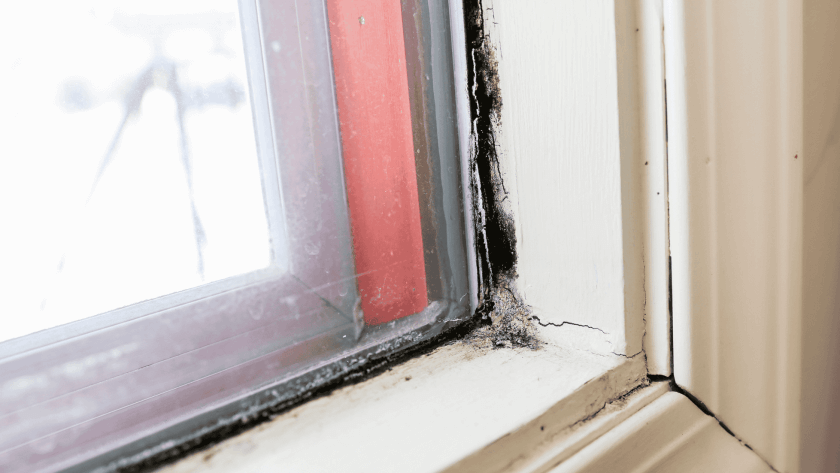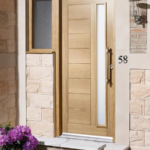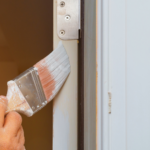“Is mould dangerous?” is one of the first questions we’re often asked during discussions about managing and removing mould from wooden doors and windows. And the answer is that yes, it certainly can be.
Most types of mould grow in damp conditions where there isn’t adequate ventilation and appear as a collection of black, green or grey spots. Some mould spores are highly toxic, but much of it looks alike so it can be hard to tell exactly which kind of mould species you have without an expert diagnosis.
But, even if it’s not the highly toxic kind, most black mould will at the very least exacerbate breathing problems and cause respiratory irritation, so it’s always worth removing it from your home as soon as possible.
If you have a whitish coating on the surface of your wooden doors and window frames rather than the dark spots of black mould, you likely have mildew. Mildew is another form of fungus that can be similarly bad for your health, it can also cause your doors and windows to rot and warp, which can be problematic in itself.
Here, we’ll offer you our top tips and tricks on how to remove mould and mildew patches and how to prevent too much moisture building up, ensuring they don’t return.
We need to start by asking ourselves “why are my doors mouldy in the first place?” because it’s important to get to the root cause to stop it happening again and as they say, prevention is always better than cure!
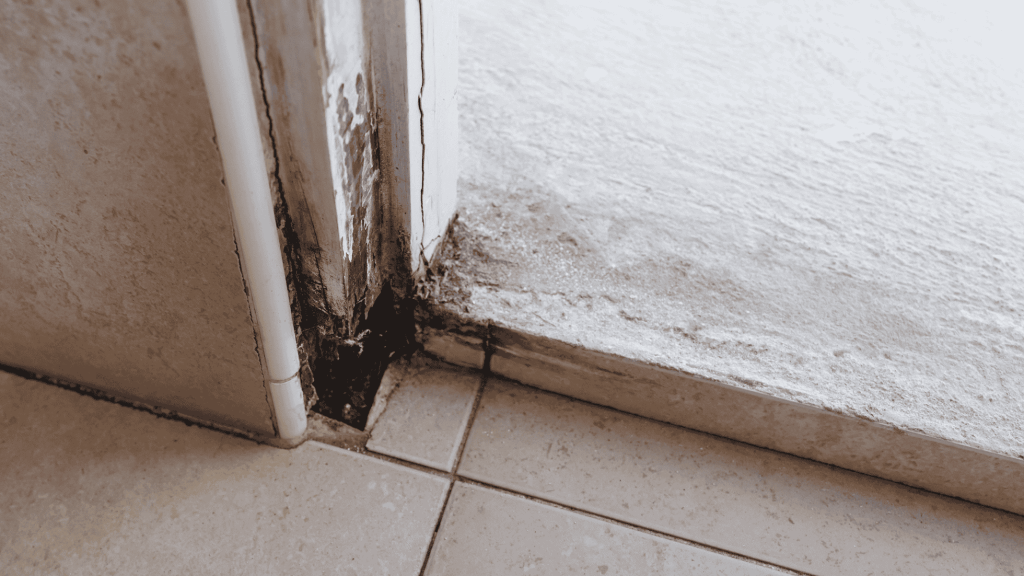
What causes mould in a house?
Whether you have a mouldy door seal, mouldy window sills or mildew on your door frames, your first step to get rid of mould is to identify the underlying cause.
So what causes mould to grow in your house?
Simply put, it’s excess moisture, and this moisture will usually come from damp or condensation.
Rising Damp
There are several forms of damp that could be leaving you with mould on your doors and windows. Rising damp is moisture that is trapped beneath the house and rises up through the walls in order to escape into the air.
Water Leaks
Water ingress is damp caused by a leak in the fabric of the building, which allows rainwater to seep in, so if you have a mouldy front door, check for air gaps around the frame. Leaking pipes can also lead to damp appearing around your home.
Excess Moisture & Condensation
Condensation occurs when humidity levels are increased. As humidity increases, the air becomes saturated with water until it can’t hold any more. When this happens, the excess water appears as droplets on surfaces such as windows, mirrors and walls. The colder the surface, the more susceptible it will be to condensation.
You’ll have seen this effect in the bathroom when you step out of the shower. The bathroom air will have become saturated with water and will have fogged up many of the surfaces with the water it can’t hold.
But it’s not just showering that can cause condensation in your home.
Cooking, drying clothes indoors and even breathing will cause excess moisture, and without proper ventilation will increase the chance of that moisture being left on your walls and doors and window sills.
Single glazing is particularly susceptible to condensation during the colder months due to the fact there’s no insulating gases between the panes like there is in double or triple glazing.
If you find you’re getting a lot of condensation on your double glazed doors and windows, it’s a good indicator that it’s time to replace the glazing unit as the gases are no longer present and the insulating properties have been lost – this will also affect your energy bills.
It may be damp that caused that unsightly mildew on your wooden door, or condensation that has left you with mould around your door frames. But, whatever the cause and effect, mould and mildew must be dealt with so that any mould spores are eliminated, your air is clean, and your wooden doors and windows are looking good as new for as long as possible.
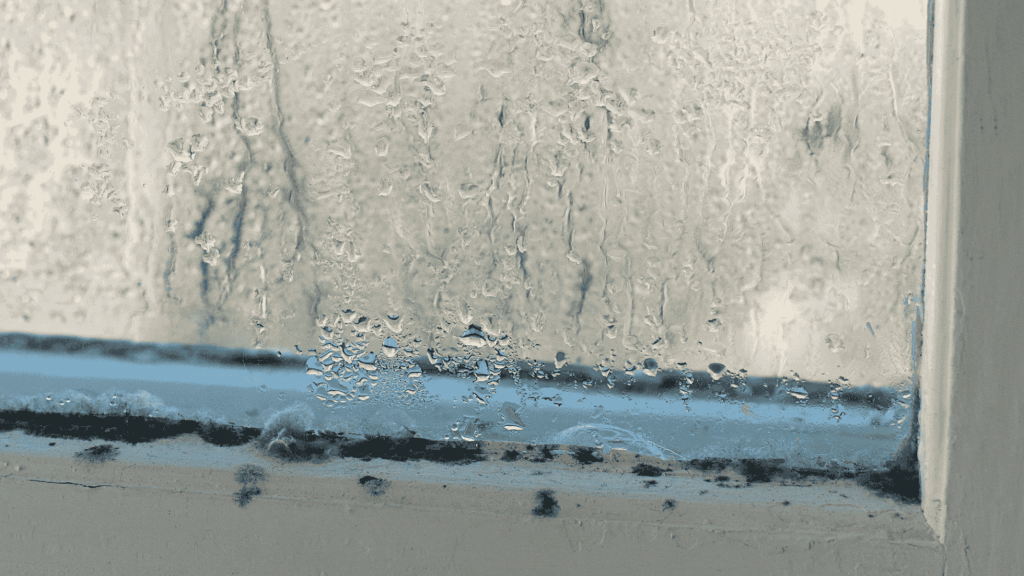
Can mould damage the wood on doors and window frames?
Yes, unfortunately mould can damage the wood on doors and window frames. As we’ve already mentioned, mould grows in damp, humid conditions and if left, can penetrate wood leading to decay, warping and discoloration.
Over time, if left untreated, mould can weaken the wood’s structure, compromising its integrity and requiring replacement. Not only can it affect your doors and windows, but it can infiltrate the rest of your home too, getting into walls, floors and soft furnishings giving them a musty smell and ultimately, increasing the chances of serious health problems if allowed to spread.
Preventing mould by reducing indoor humidity and treating affected areas quickly can help protect wooden doors and window frames from long-term damage.
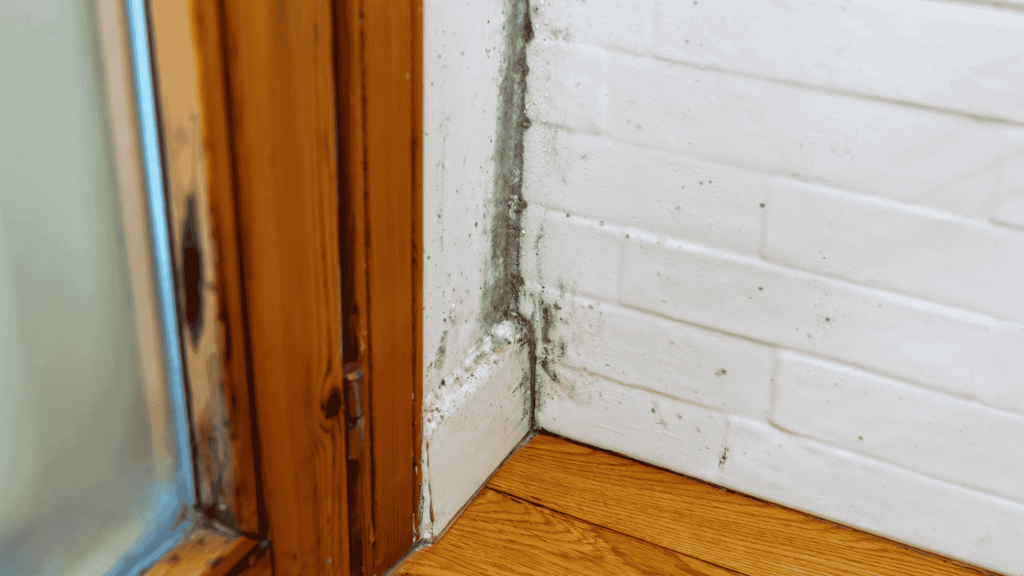
How To Clean Mouldy Doors and Windows
When it comes to mould removal from materials such as uPVC, glass and aluminium, it’s usually simply a case of washing the surface clean with a mild detergent solution, but wood is more porous and treating mould on a wooden window frame or door is more complicated as the mould can actually set up home beneath the surface.
If your door or window is fully finished or painted wood, the mould is unlikely to be able to penetrate the surface unless it’s damaged or split, and should be effectively removed with the mild detergent solution mentioned below.
If your door is unfinished or the surface is damaged, your approach to remove mould will need to be a little more thorough and there’s a higher chance you may need to actually replace the wood.
While it may take a little longer, whether you’re removing black mould, or getting rid of white mould from wood, it is not a difficult job, and you shouldn’t need any special equipment to do it.
What household products are effective for cleaning mould from wood?
Several household products can effectively clean mould from wood. White vinegar is a natural, gentle solution that will kill mould spores on wood without damaging the surface. Baking soda, when mixed with water, can scrub away visible mould and deodorise.
Hydrogen peroxide is also effective for mould on wood, as it can penetrate the wood surface to kill mould and spores below. Diluted dish soap with warm water can help clean mould off sealed wood surfaces and is a safe choice for frequent use. Always dry wood thoroughly after cleaning to prevent mould recurrence.
For stubborn mould, testing a small area with a diluted bleach solution (1:10 ratio) may help, though bleach is best reserved for non-porous surfaces, as it may not reach deep-set mould in wood.
So let’s get on and explain how you can get mould off wood:
- Step 1: Choose a suitable cleaning solution and add it to a spray bottle. It’s important to note that if you use the bleach solution, don’t combine it with a detergent that contains ammonia as this will produce dangerous gases. Do however choose a bleach that contains surfactants as this will ensure the bleach penetrates the surface of the wood to kill the mould at its root.
- Step 2: Put on appropriate protective clothing. This job will require you to protect yourself from the mould spores and potentially the cleaning product too, so we’d recommend a facemask and goggles to protect from spores and fumes, rubber gloves, and possibly overalls if your skin is sensitive to the mould.
- Step 3: Spray your cleaning solution so that it covers the area to be cleaned and let it sit there for a minute or two before scrubbing the area thoroughly with a damp cloth or low-abrasive scourer or brush. Work hard to ensure all traces of the mould or mildew are removed, and then wipe any excess solution away.
- Step 4: Rinse the doors with clean water and a fresh sponge, dry it off with a clean cloth, and ensure the area is really well ventilated to help the door or window frame dry out completely. If, once it’s dry, traces or odours of mould are still present, repeat the process.
And when it comes to keeping your doors and windows mould and mildew-free the solution is to keep the area around them as clean and dry as possible.
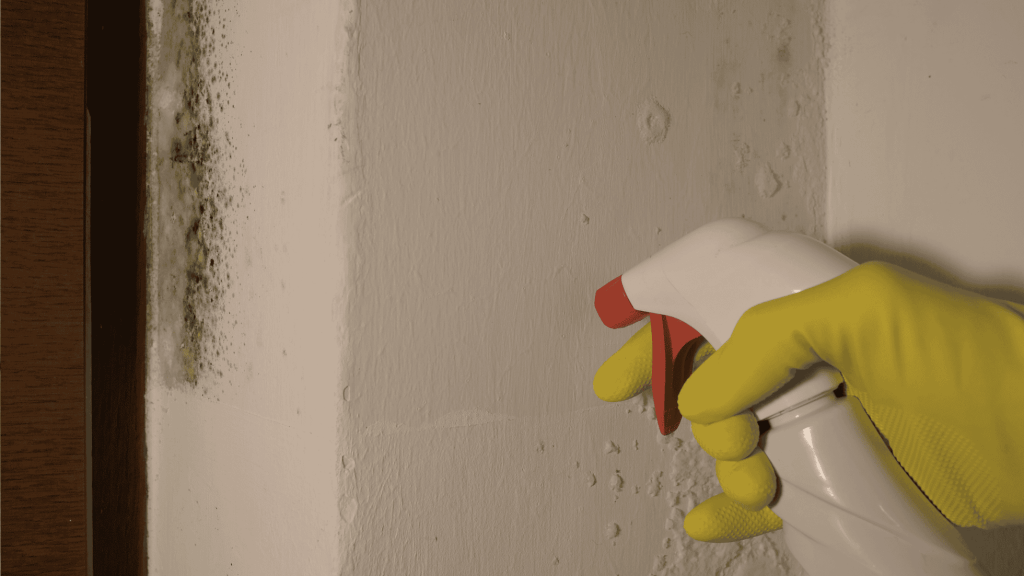
How quickly can mould return after removal?
Mould can return surprisingly quickly after removal, especially if conditions remain favourable for growth.
Mould spreads and in humid or damp environments with poor ventilation, mould can reappear within as little as 48 hours. Effective mould prevention means keeping the area dry, you need to ensure proper ventilation at all times to reduce moisture levels and improve air quality.
Be sure to address any underlying moisture issues such as leaks, as well as thoroughly removing the mould that’s grown as this is essential to prevent recurrence.
How to Prevent Mould Growth on Wooden Doors & Windows
To make sure the mould doesn’t return or to even prevent mould growth on wooden doors and windows in the first place, keep these simple strategies in mind:
Control Moisture and Ventilation
As we’ve mentioned already, mould thrives in damp, poorly ventilated areas. It’s important to keep damp under control as much as possible. Use dehumidifiers or air conditioners, especially in humid seasons, to lower moisture levels.
Regularly open windows or use exhaust fans in rooms like kitchens and bathrooms. If you don’t have an extractor fan above your cooker top, now is the time to invest in one!
Move Houseplants
As lovely as they are to look at, unfortunately houseplants do increase the humidity of a space, providing the ideal breeding ground for mould spores. You may find those windows and doors that are continually close to plants are more prone to mould growth.
Periodically move your houseplants around to ensure the space is given a “break”, or place them somewhere with better airflow to prevent moisture hanging around too much.
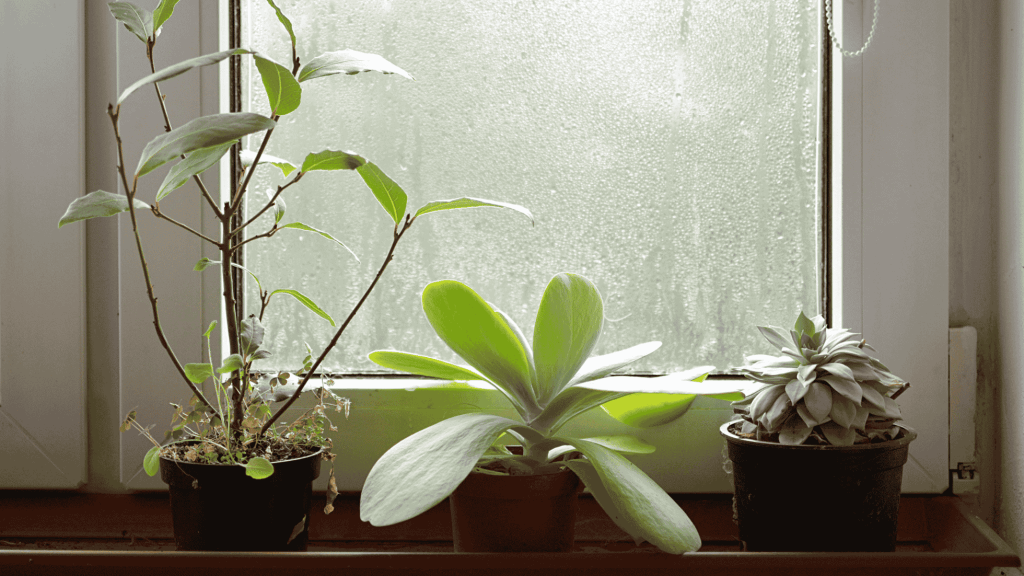
Seal Gaps and Cracks
Inspect your doors and windows for cracks or gaps where water can seep in. Proper sealing and caulking will help keep moisture out, protecting your wood surfaces.
Regular Cleaning and Maintenance
It might seem like an obvious one, but clean wooden surfaces regularly with mild soap and water, and be sure to thoroughly remove excess moisture with a dry rag from the area you’ve cleaned. Avoid heavy saturation, as prolonged water exposure in even the smallest of nicks and crevices can promote mould growth. Use a mould-resistant cleaner periodically to discourage spores from taking hold.
Treat and Protect the Wood
Applying mould resistant paint or wood sealants on both the inside and outside can create a barrier against moisture. This is particularly helpful for exterior wooden doors and windows that get more exposure to rain or high levels of humidity, such as those in a bathroom.
Remove Any Mould Quickly
As we’ve mentioned above, time is of the essence when it comes to mould. If you notice mould starting to form, clean it immediately using a suitable solution or specialised wood-safe mould removers. The quicker you address mould, the less likely it will spread.
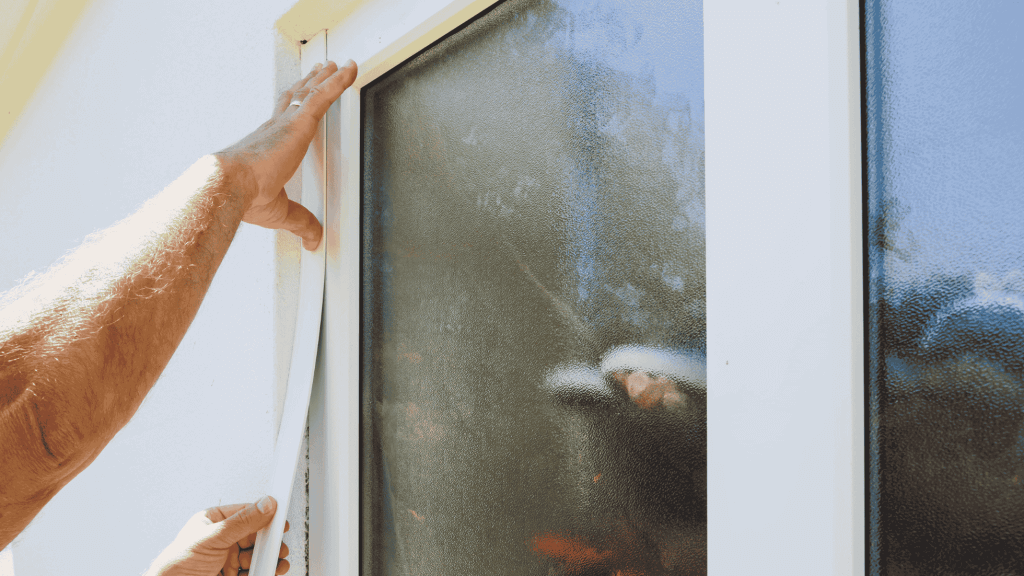
For You And Your Home
Removing mould from wood, or any other material for that matter, is an important task that should be done as soon as possible to maintain a happy and healthy home.
It’s not a difficult job and the benefits to your health and the look of your home are huge. So set aside an hour or so, and give your doors (and yourself) some much deserved TLC!


